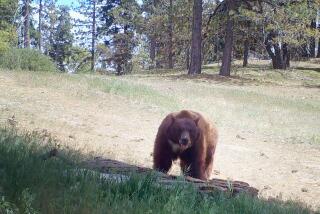After quarantine, bison find a new home on the range in Montana
One after another, the bison came storming out of the back of an 18-wheeler, down a metal ramp and onto the snow-covered prairie at Fort Peck Indian Reservation in northern Montana.
A Sioux drum group welcomed the first shipment of wild bison, and a video camera captured the animals galloping around their new home. They had spent 10 hours Thursday traveling from a ranch owned by media mogul and philanthropist Ted Turner near Bozeman.
That is where the bison had been quarantined for nearly five years as part of an experiment to see whether the genetically pure bison that roam Yellowstone National Park could be removed from the park without taking the dreaded cattle disease brucellosis with them. More 18-wheelers filled with bison followed that first shipment until 138 bison were set loose on reservation land.
The move was the latest step in a long battle to find a place for the bison to roam outside Yellowstone, where thousands of their kind have been killed over the last 20 years under a government program aimed at preventing the spread of brucellosis. Earlier attempts to relocate the quarantined bison had been delayed in part by livestock owners’ concern over spreading the disease, which can induce abortions in wildlife and livestock.
Now shown to be free of the disease, the animals were hauled to the Fort Peck Indian Reservation where, environmental advocates hope, they can begin to restore some semblance of ecological balance to the plains they once roamed by the millions.
For the Assiniboine and Sioux tribes at the reservation, the move felt more like a homecoming than government experiment, said Robert Magnan, the fish and game manager at the reservation.
“It’s great to bring some full-bloods home,” he said. “We feel they are connected to our ancestors. The buffalo have been with Native Americans since the beginning.”
The Yellowstone bison are descendants of two dozen or so wild bison that remained in the park as the species teetered on the edge of extinction in the late 19th century. Unlike most other bison that remained with ranchers, the Yellowstone bison were never crossed with cattle to improve their meat.
The Yellowstone herd represents a portion of the original gene pool, making the group central to future conservation efforts, according to a federal government report released this year.
The reservation received its first shipment of genetically pure wild bison, also part of the quarantine experiment, in 2012. They were the first bison to graze that land in 145 years.
The tribes gave about half of their 73 bison, often referred to as buffalo, to the neighboring Fort Belknap Indian Reservation. Magnan said they hoped to provide bison to more tribes in the future.
Overall, it has been an exciting time for bison advocates, Magnan said. “People are now realizing that buffalo ain’t the boogeyman they have been made out to be,” he said.
The experimental quarantine program has ended, but its success in getting disease-free bison out of Yellowstone has led National Park Service officials to propose developing a more permanent quarantine program within Yellowstone or on tribal lands.
Montana Gov. Steve Bullock, a Democrat, unveiled a plan last week that would allow bison to roam west of the park year-round but only if their population dips below 3,500 from its current 4,900. Hungry bison sometimes leave the higher elevations of the park in search of forage in winter.
It is the first time that a Montana governor has recognized the need for bison habitat outside the park, said Barb Cestero, Montana conservation coordinator for the Greater Yellowstone Coalition.
Still, the group finds the population requirement counterintuitive. “It’s like saying the bigger your family, the smaller the house you get,” she said. “We have concerns about that, but this is an issue of incremental steps.”
Montana officials are expected to complete a new bison management plan next year that could allow wild bison to roam other parts of the state.
Though livestock owners have looked askance at previous relocation efforts, last week’s move is a welcome development, said Dennis McDonald, a former president of the Montana Cattlemen’s Assn. who owns a ranch just north of Yellowstone.
“The problem in Yellowstone is we got too many bison,” he said, “so giving that herd to the Native American population and creating different opportunities for that herd to flourish is wonderful.”
An earlier attempt to relocate the quarantined bison in 2010 was opposed by livestock interests, which led to Turner hosting the herd on his ranch while a permanent home was found. In exchange, he received 75% of the herd’s offspring.
Many livestock owners have been put at ease by the extra years of quarantine, said Jay Bodner, natural resources director for the Montana Stockgrowers Assn. Owners are now more concerned about bison potentially breaking fences or escaping enclosure.
“The disease factor is very low, the risk is very low,” Bodner said. “Right now it’s no different from my neighbor owning livestock; so as long as you keep them on your side of the fence, we are good.”
Environmental advocates and scientists are eager to see how the bison will transform the 13,000 acres of prairie where they will be free to roam.
The hulking animals play a key role in the ecosystem, said Jonathan Proctor, a conservationist with Defenders of Wildlife. When they wallow in the dirt, for example, they create divots that serve as watering holes for prairie dogs and other animals. Their fur provides lining for birds’ nests, and their large carcasses ample food for scavengers.
“There could be all sorts of roles that bison once played that we are not even aware of — yet,” Proctor said.
More to Read
Start your day right
Sign up for Essential California for news, features and recommendations from the L.A. Times and beyond in your inbox six days a week.
You may occasionally receive promotional content from the Los Angeles Times.







